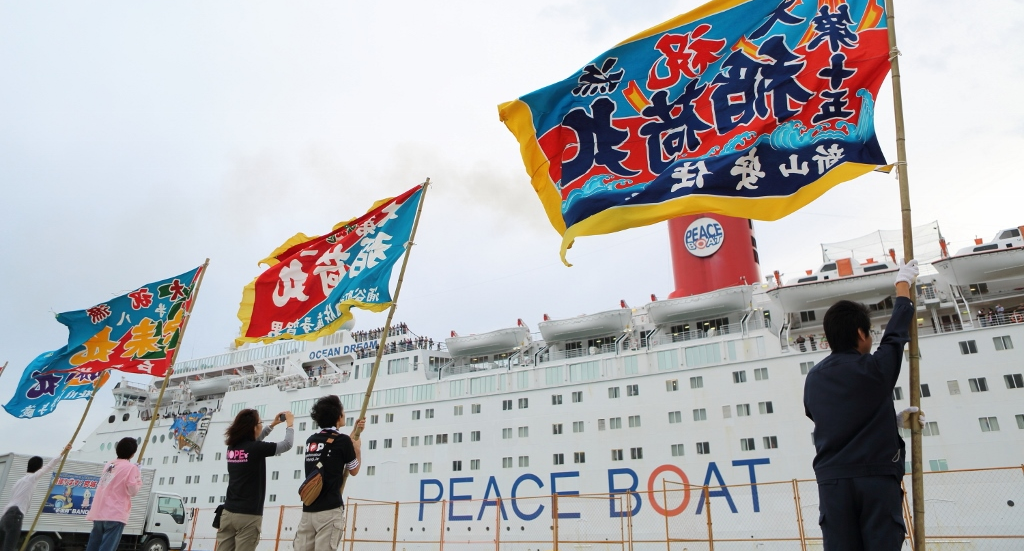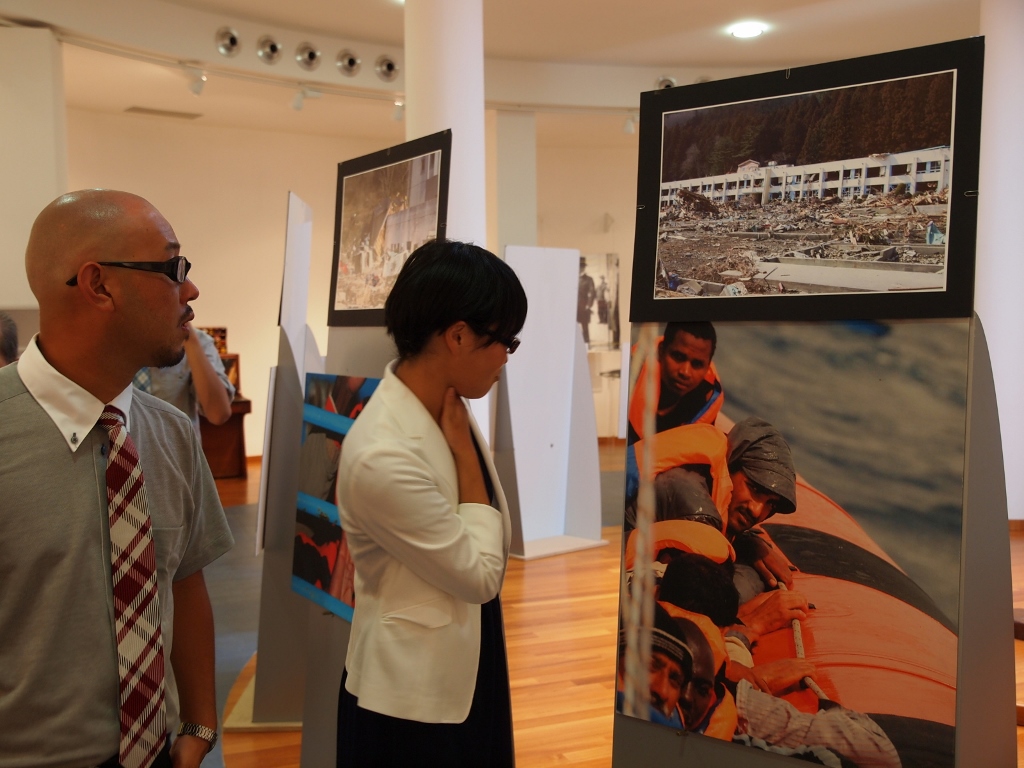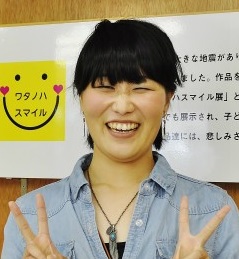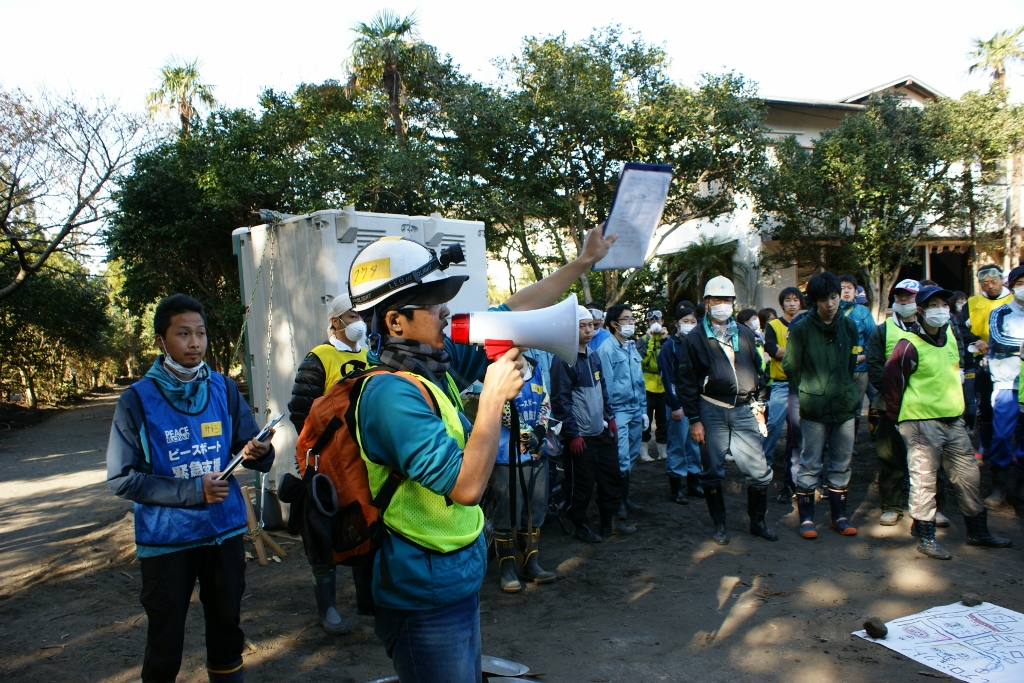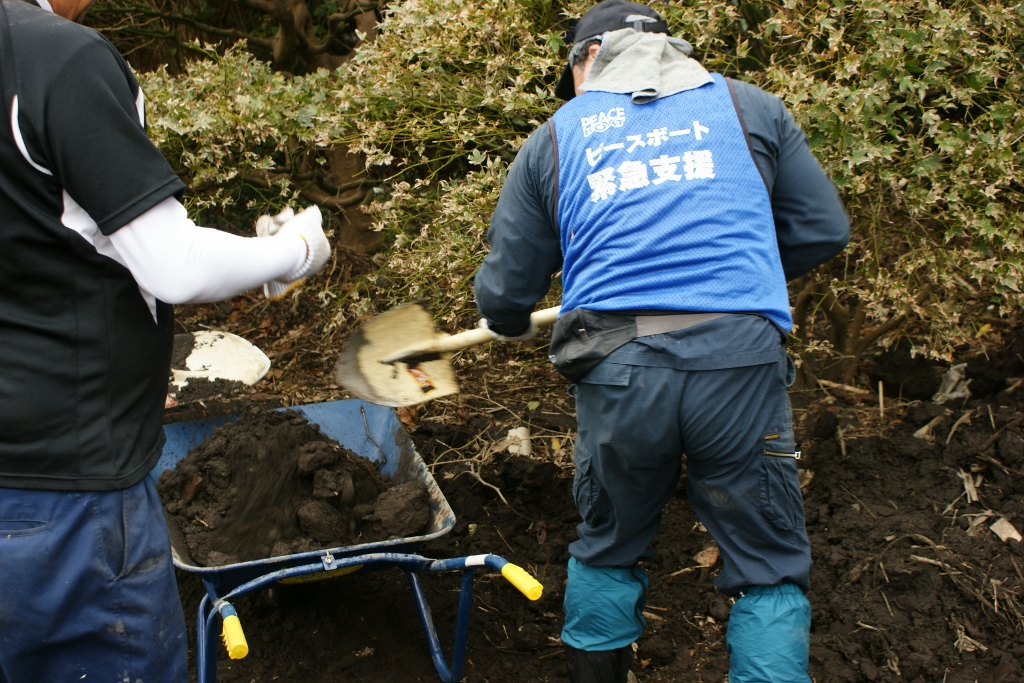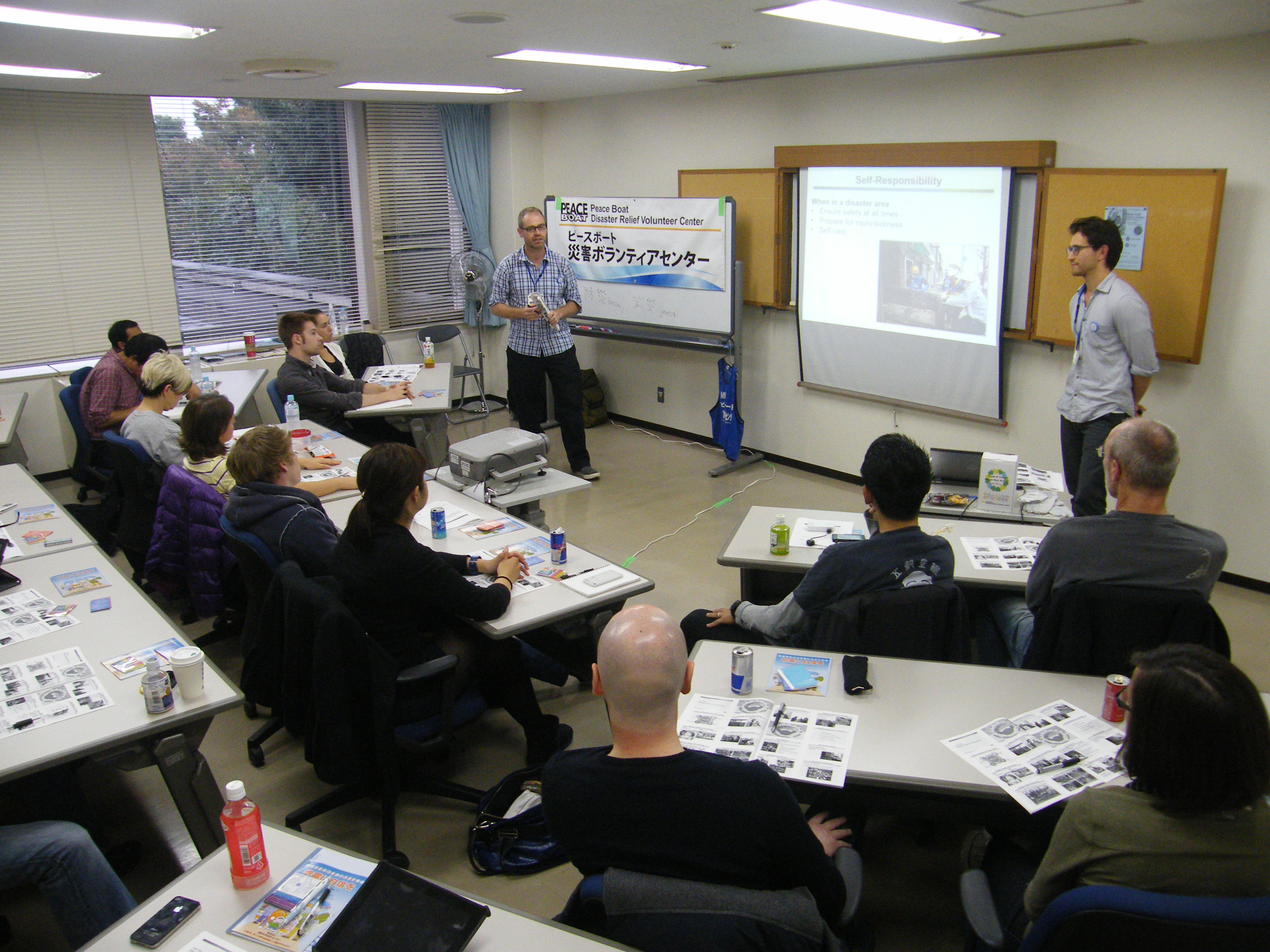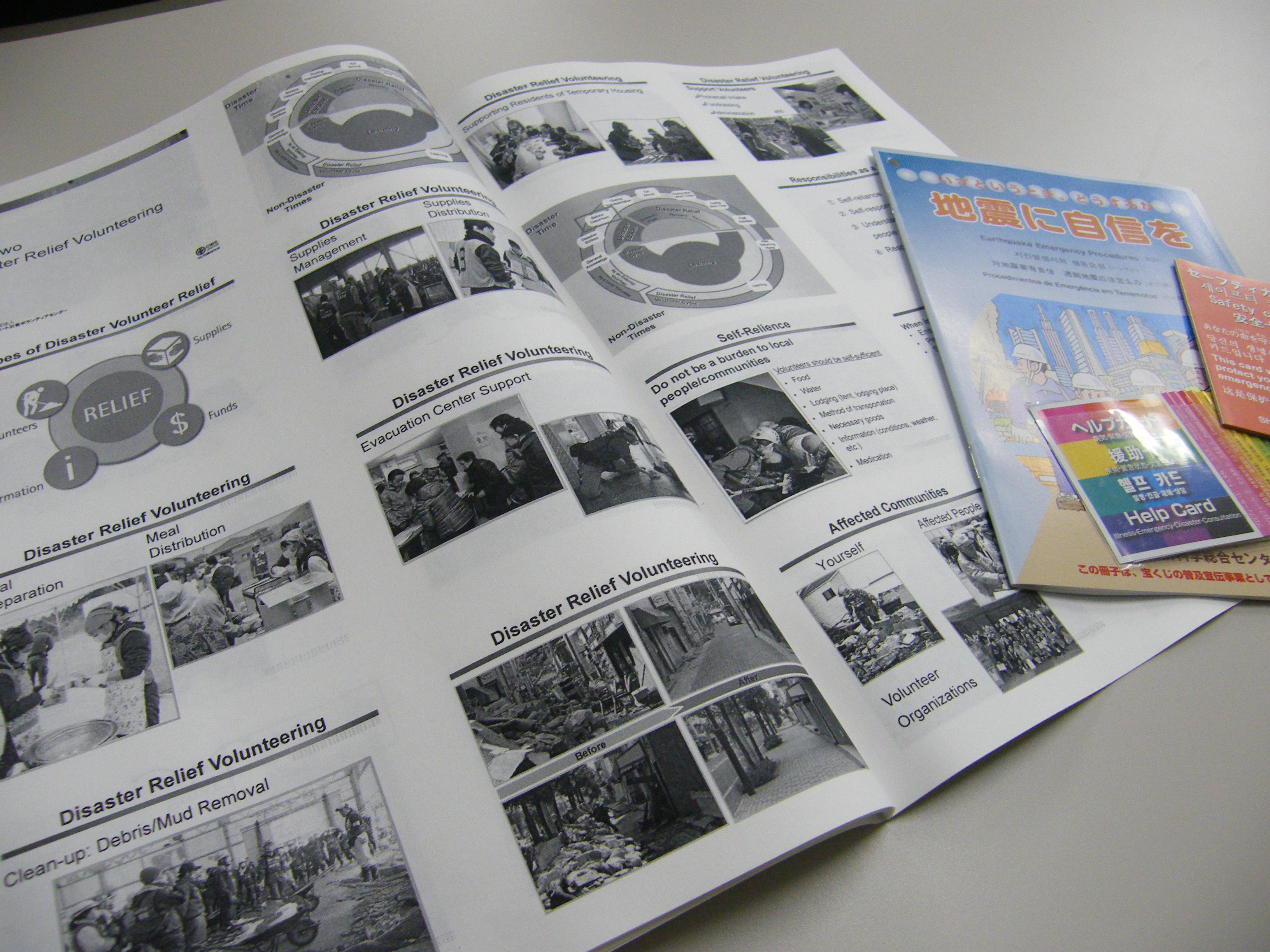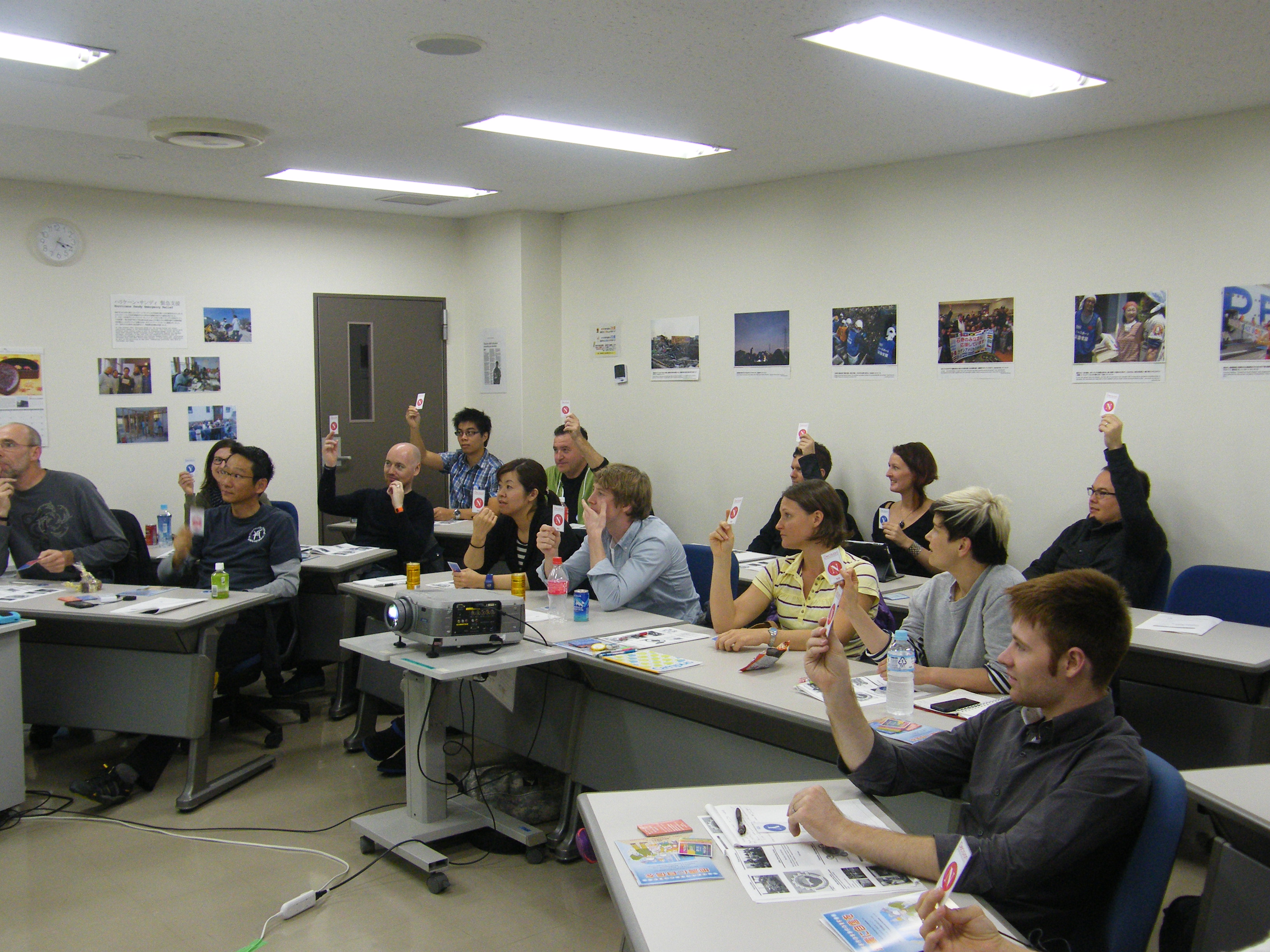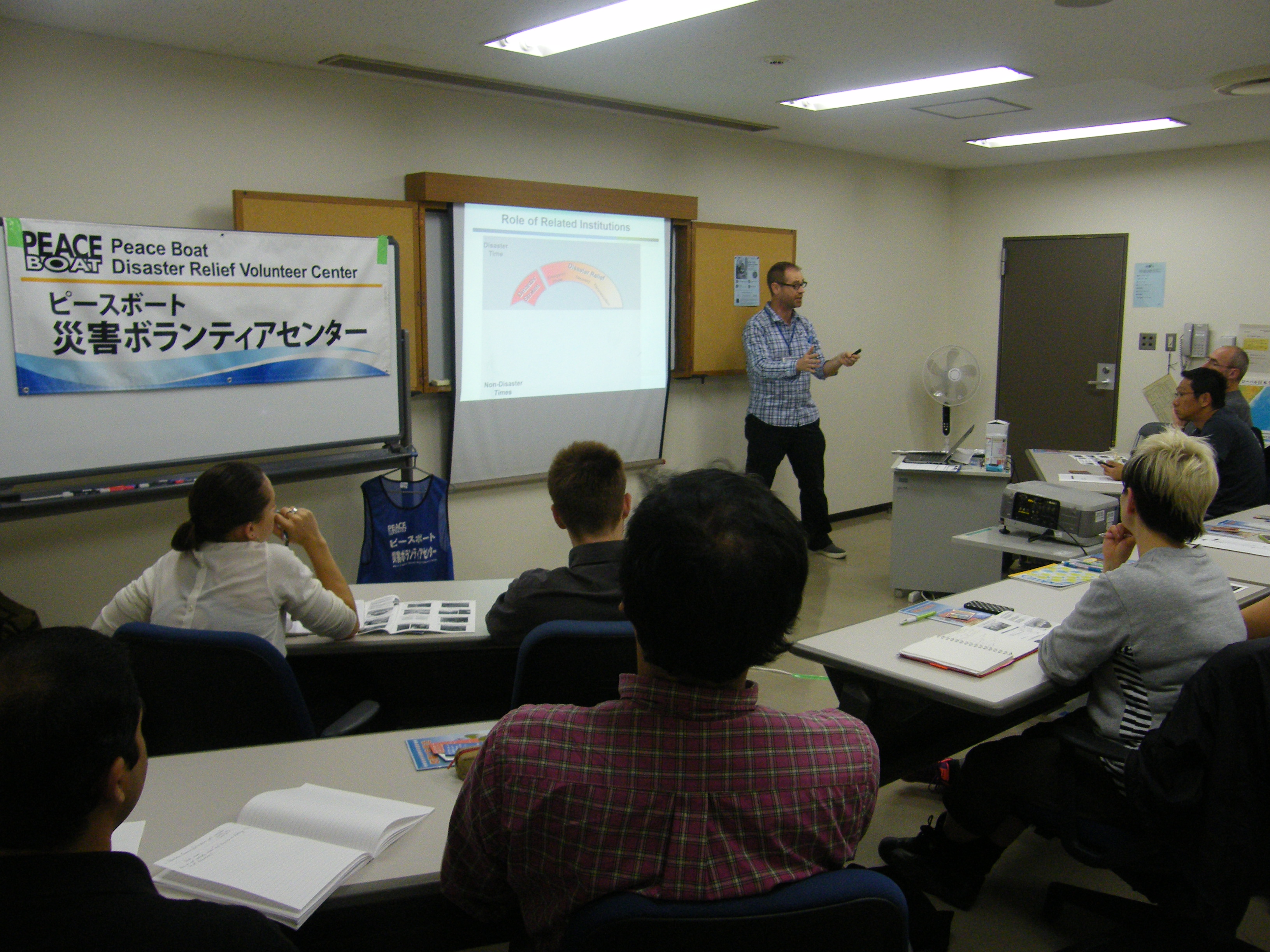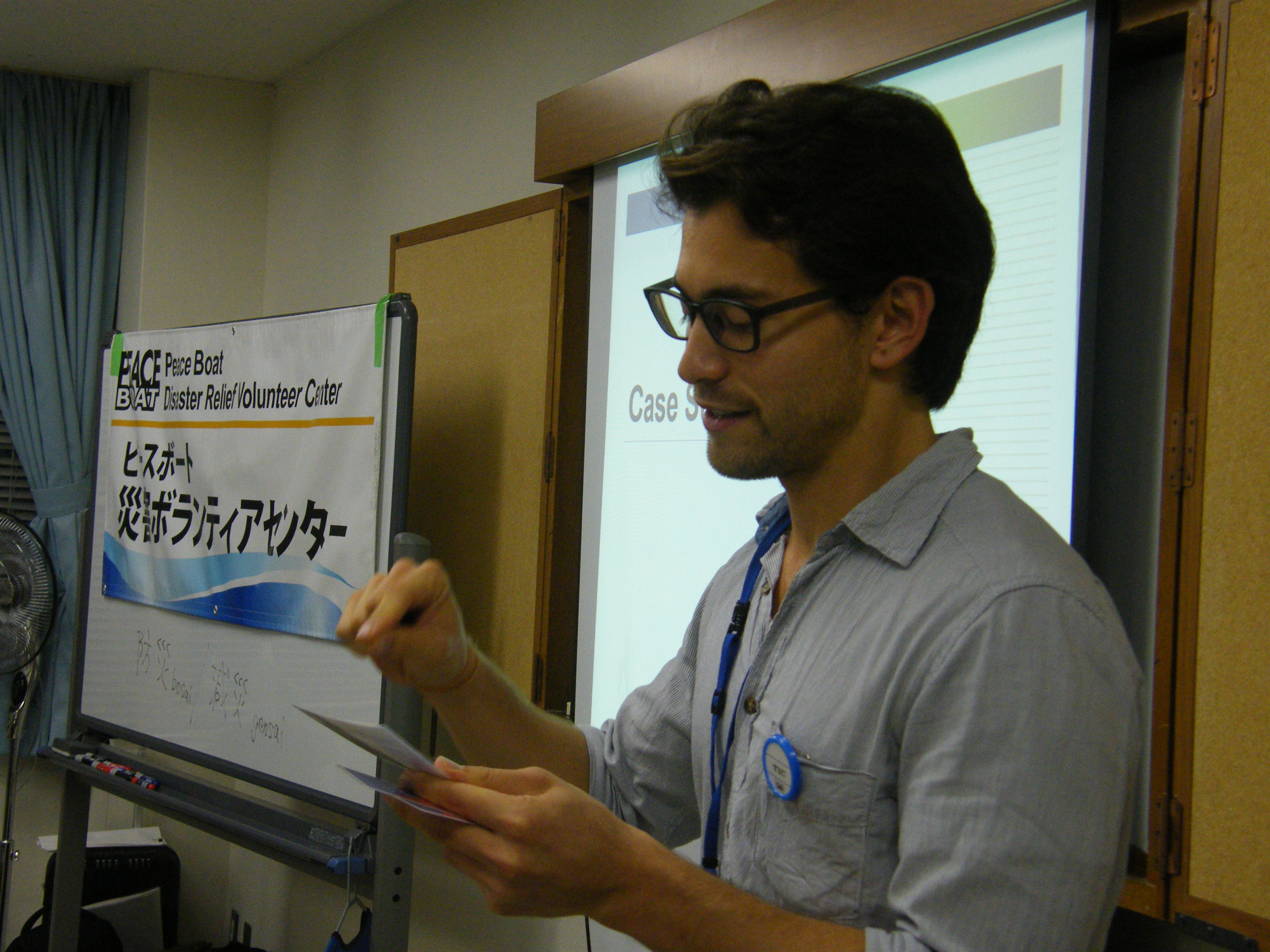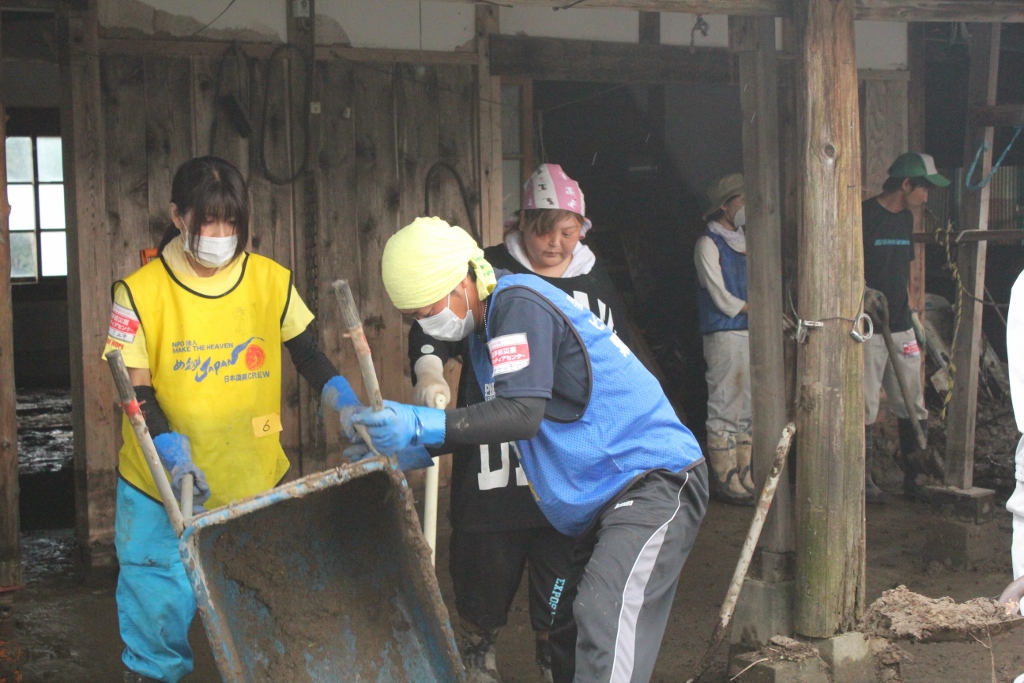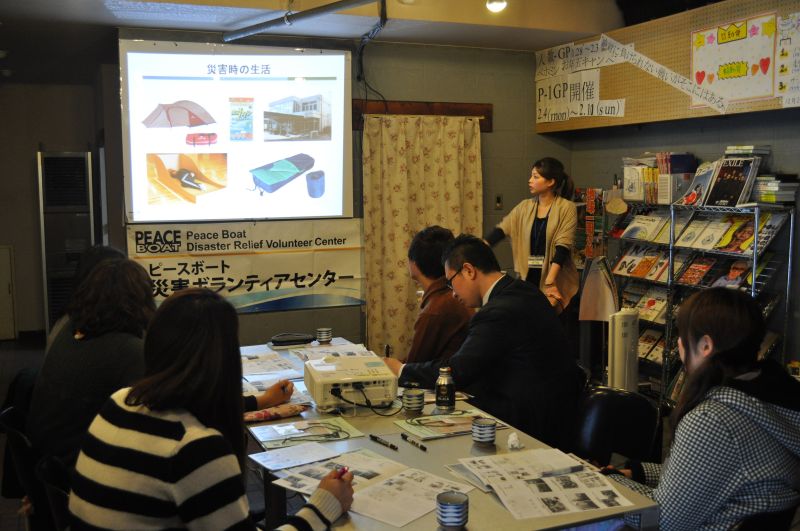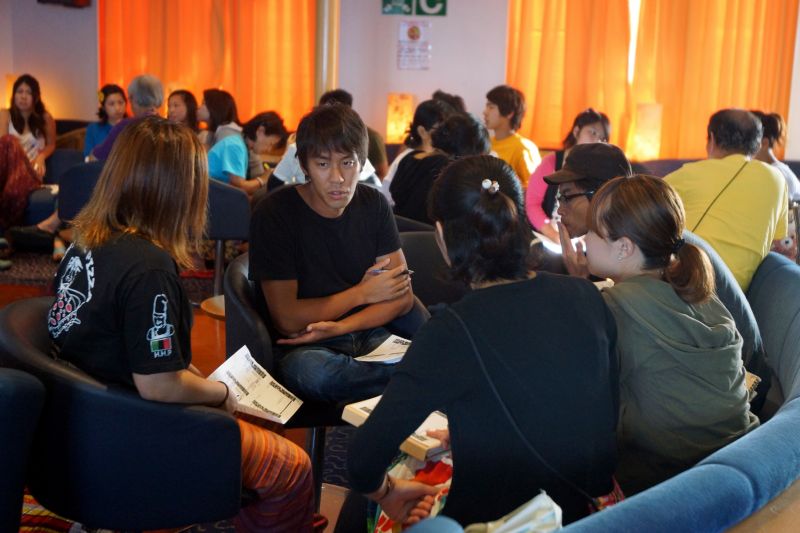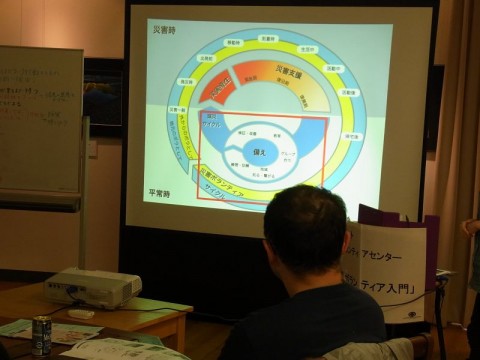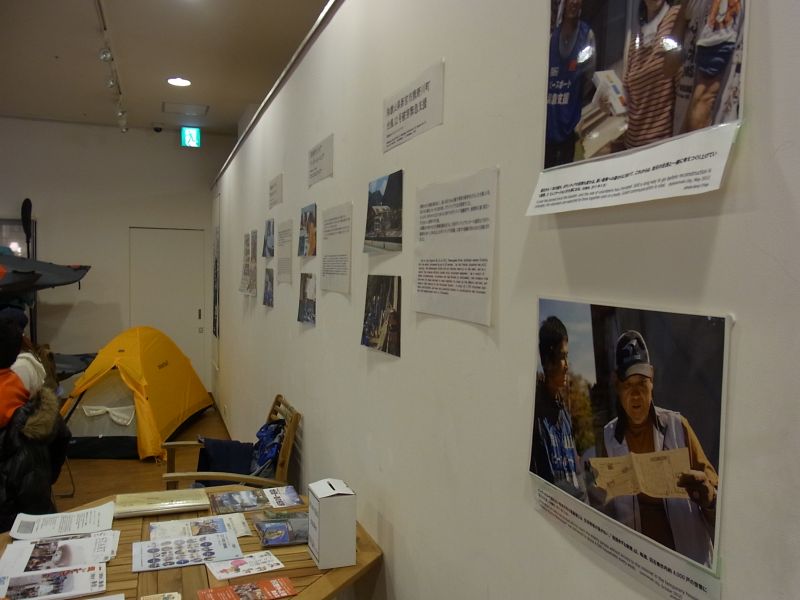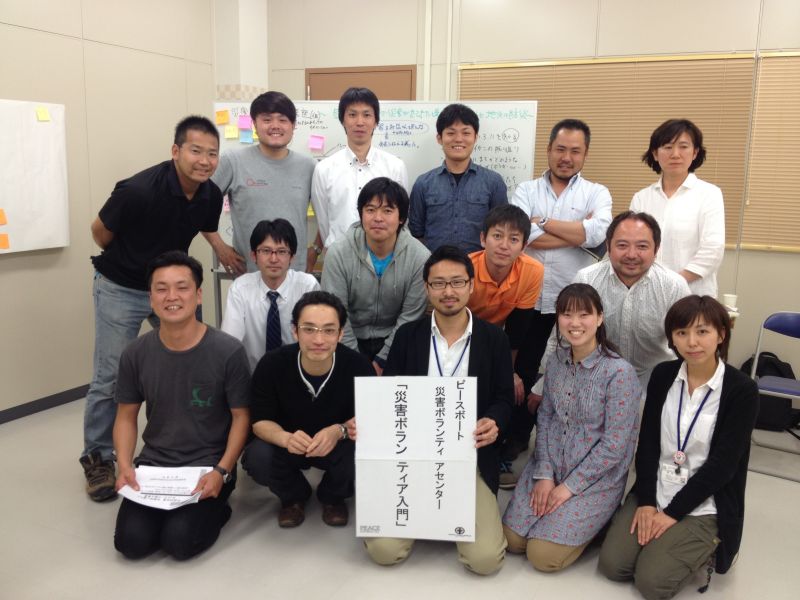
News
Ishinomaki Youth Ambassador Project Report
January 15, 2014
Youth Ambassadors from Ishinomaki City, Miyagi Prefecture joined the 80th Peace Boat Global Voyage this past fall in order to share their experiences and lessons learnt from the Great East Japan Earthquake and Tsunami. After their return to Japan, they held a debriefing session in both Tokyo and Ishinomaki, and visited the office of the mayor of Ishinomaki, who graciously supported their endeavor.
Youth Ambassadors were chosen by open application whereby applicants had to submit an essay and undergo a casual interview. The two selected from this process boarded the 80th Peace Boat Global Voyage from Yokohama on July 19th for an 85-day trip spanning 20 ports in 19 countries. On board, they held programs sharing their experiences of the Tohoku disaster, as well as numerous projects including making symbolic Tairyou-Bata (a type of bright, decorative flag used by fisherman to signify a big catch). They held similar events and activities in the ports-of-call, sharing with locals their first-hand experiences of the disaster and the current situation of the affected areas.
Peace Boat’s 80th Global Voyage
Dates: 7/19 (Thu) ~ 10/10(Thu)
Total 85 days, Departing and Returning from Yokohama
Name of Vessel: Ocean Dream
Total Weight: 35,265 metric tons
Size: Total Length, 205 meters; total width, 26.5 meters; draft, 7.5 meters
Locations visited:
Yokohama, Japan
Da Nang, Vietnam
Singapore
Kochi, India
Limassol, Cyprus
Kusadasi, Turkey
Piraeus, Greece
Valletta, Malta
Civitavecchia, Italy
Monaco
Marseilles, France
Barcelona, Spain
Malaga, Spain
Casablanca, Morocco
Funchal, Portugal
Santa Domingo, Dominican Republic
Montego Bay, Jamaica
Cristobal, Panama
Acajutla, El Salvador
Manzanillo, Mexico
Ishinomaki, Japan
Yokohama, Japan
Schedule of Activities
7/19 Yokohama, Japan; departure press conference
7/24 Da Nang, Vietnam; Speech at a international exchange conference between Japanese and Vietnamese youth celebrating 40 years of Japan-Vietnam relations.
8/22 Civitavecchia, Italy; Civitavecchia, which is one of Ishinomaki’s sister cities, held a testimonial session where the two Youth Ambassadors shared their experiences of the Tohoku Disaster, and the current state of the region. Politicians, government workers, educators and others were in attendance.
8/26~8/28 Coria Del Rio, Spain; Testimonial session with the Japón (originally Hasekura de Japón) people of Coria Del Rio, who claim to be descendents of Hasekura Tsunenaga’s delegation.
9/11 Montego Bay, Jamaica; Testimonygiving event with the Montego Bay Boys and Girls Club. Since it was the monthly anniversary of the Tohoku Disaster, after the testimonial session they performed a silent prayer out to the ocean.
9/22 Manzanillo, Mexico; To commemorate the “International Day of Peace,” participated in the “Mexico-Japan peace and friendship festival.” Among the over 6000 participants included numerous governors, mayors, teachers and civil servants.
10/9 Ishinomaki, Japan; The Peace Boat entered Ishinomaki, the final port-of-call on the voyage, flying their Tairyou-Bata. On these giant flags were messages of hope from each country the Peace Boat had visited. There was a welcome ceremony put on by residents of Ishinomaki, Onagawa, Higashi-Matsushima, and Matsushima. The Peace Ambassadors also made a speech. After the ceremony, the passengers of the Peace Boat were shown around Onagawa and Ishinomaki.
10/10 Yokohama, Japan; Press conference upon return.
10/27 Ishinomaki, Japan; Youth Ambassador Activity Report
11/27 Tokyo, Japan; Youth Ambassador Activity Report
The Youth Ambassadors also participated in many activities onboard the ship. (see activity reports Vol 1-7)
Reflections
“Through this voyage, I was able to see my hometown from the outside for the first time. I used to hate my hometown – I didn’t know what was appealing at all. But after the Tohoku Earthquake, I was able to meet many people, and I began to realize that Ishinomaki has many wonderful people and interesting places. Through this trip, I was able to visit many countries, see many different regions, and connect to many different people by talking about Ishinomaki. By the end, I felt that it is possible to connect to places around the world through people. Even though I had never really traveled much before this, I was able to tell many people about Ishinomaki and through those conversations many people began to care about my town. In turn, through talking to people throughout my travels, I developed many friendships and connections to places around the world. Through this kind of exchange, I feel that regions far away can connect to each other.
There were many people that worked tirelessly to welcome us in Ishinomaki, whom I was able to admire from the outside. Coming from a town that has such amazing people, I felt that I should gain more confidence to be able to say “our town is amazing, please come and visit!” Going forward, I want to keep striving to make Ishinomaki an even more appealing and charming place.
- Sayaka Takahashi -

Of course the Tohoku disaster caused tremendous pain and hardship for us all. But from my experiences while working in a shop in Onagawa and focusing on the area’s recovery, I’ve seen there are many people really moving positively around me. These people are looking to build an even better Onagawa, despite the damage caused by the disaster. While the current status of rebuilding is important, I think we must note that people in Onagawa are moving positively, because I have strongly felt regardless of whether it is an earthquake or conflict, the power of people to try to recover is truly incredible.
I was able to confirm this feeling again in many different countries during the voyage around the world. I also wanted to share my own positive power. It was very valuable for me to have a place to share with people around the world my feelings for Onagawa – my town that I really love. Finally, I was also really happy to be able to show the passengers of the Peace Boat around Onagawa and to hear them say “It was fun!” and “I’m glad I came!”
From now, I will continue to have a base in Onagawa and continue my work. In my travels, I also saw that there are people that have it much worse than us. The fact that it is not only Tohoku that is going through hardship hit me very hard, and I will keep that reality in mind going forward.
I really want to thank everyone who made this voyage possible.
Thank you so much!
- Shuhei Sakimura -
Oshima Relief – Final Project Report
December 11, 2013
Typhoon #26 battered the Izu Islands, a chain of islands just south of Tokyo, on October 16th. Oshima Island was the hardest hit, where severe flooding and landslides left communities devastated in the wake of the typhoon. Unrelentingly, typhoons #27 and #28 also exacerbated the situation when they passed through the same area in quick concession.
PBV commenced relief operations in Izu Oshima on October 30th, making it the 5th domestic relief project of this year for our organisation.
The advanced team, consisting of 3 experienced members of staff, assessed damaged areas and established contact with local organisations such as the Social Welfare Council and other disaster relief groups working in the area.
Working closely with the “Tokyo Disaster Volunteer Center”, PBV coordinated 263 volunteer work days over the course of a month. After a comprehensive post-assessment of the affected areas, we officially wrapped up our operations on Oshima on November 29th.
PBV’s work consisted of the following: cleaning privately owned houses that had been damaged during the typhoon, serving as team leaders for other volunteer groups and assisting with the running/maintenance of the Oshima Disaster Volunteer Center, which was run by the Oshima Social Welfare Council.
Thank you to all of those who have been involved with fundraising and supporting our project in Oshima Island.
Our work to help families affected by this disaster would not have been possible without the dedication and hard work of countless individuals.
English-language Disaster Relief Training on November 2nd
November 13, 2013
PBV held an English-language Disaster Relief Volunteer Training seminar on November 2nd which was attended by 19 participants from 10 different countries.
Non-Japanese nationals are often considered a “vulnerable” group in disaster time, due to potential language and cultural barriers which may inhibit a full understanding of the situation and effective actions necessary to protect one’s self.
PBV believes in empowering, engaging and educating this “vulnerable” segment of the population to not only protect themselves after a major disaster, but to also help others.
The impact of non-Japanese volunteers was evident in the wake of the Great East Japan Earthquake and Tsunami, when thousands of individuals mobilized to the afflicted regions to assist affected communities.
In the aim of enhancing and harnessing this kind of potential for future disasters, PBV organized an English-language Disaster Relief Volunteer Training seminar on Nov 2nd.
A diverse group of exchange students, NGO workers, teachers and executives (among many others) gathered at JICA Tokyo, each with their own unique background.
There were a number of lively discussions throughout the afternoon fueled by the participants’ experiences and perspectives on prevalent disaster-related issues.
Participants shared stories of how they were affected by the March 11th disaster, as well as how they were able to help those affected, despite differences in language and culture.
Feedback from some of the participants includes:
“The course was great. The case study was really entertaining and useful because it illustrated that there are many opinions for every individual situation that have to be taken into consideration” – participant from Belgium.
“Lots of useful information. I have experience of many things spoken about but it was great to have it refreshed and I got lots more detailed information too” – participant from Australia.
“It was very beneficial as I learnt not only about how I can protect myself and my loved ones but also how I can support people affected by disasters in the future” – participant from Japan.
PBV will continue to provide this kind of training in the future for non-Japanese and English-speaking individuals.
We will announce future trainings on the PBV English-language website and Facebook page in the near future.
Ishinomaki Fishermen join PBV relief team in Iwate Prefecture
August 30, 2013
Six survivors of the Great East Japan Earthquake from Ishinomaki travel to neighbouring Iwate Prefecture to assist communities affected by severe weather.
PBV dispatched an advanced team on August 17th to Shizukuishi-cho, Iwate Prefecture, where there was extensive damage from heavy rainfall and flooding in early August.
Over 1500 homes had sustained damage and thousands of people and livelihoods were affected by the severe weather conditions.
By August 21st, PBV had commenced relief operations in partnership with the local Disaster Relief Volunteer Center and Social Welfare Council. Volunteers from across Japan came together to remove mud and debris from flooded homes, working through the relentless summer heat.
Having heard of the extent of the damage in Iwate Prefecture following the severe weather, six fishermen agreed to join PBV’s relief team to help their neighbours in their time of need.
The six fishermen live and work in fishing villages in the Oshika Peninsula, many of which were devastated by the Great East Japan Earthquake and Tsunami.
In the wake of the 2011 disaster, a number of the fishermen worked with PBV in villages and local fisheries, working side by side to revitalize their communities.
“At the time the Great East Japan Earthquake, I couldn’t understand why so many volunteers came to help us. I couldn’t see what was in it for them. Now, having done it myself, I can understand,” remarked one fisherman.
“When I saw how bad the situation was in Iwate, I immediately wanted to help and started figuring out the logistics of going up there. However, I couldn’t take that last step to go by myself. When PBV invited me, I took them up on their offer immediately”.
The fishermen from Ishinomaki feel strongly about giving back to other communities and believe that survivors can and should take on the role of disaster relief volunteers in future disasters.
PBV is proud to be part of this kind of support network; neighbours helping neighbours and communities reaching out to help others in times of disaster.
This kind of safety net is essential to building strong, resilient communities and PBV will continue to train and mobilize disaster relief volunteers to assist disaster-stricken areas in the future.
Over 1000 Volunteers Trained Through PBV’s ‘Disaster Relief Volunteer Training’ Course
August 23, 2013
Training in Non-Disaster times – Preparing for Future Disasters
PBV believes strongly in training and developing disaster relief volunteers in non-disaster times to prepare for future disasters.
PBV aims to build a national network of disaster relief volunteers which, in the event of a major disaster, will not only be able to respond to disasters in their own areas, but will also have the capacity to assist other areas when called upon.
In the immediate aftermath of any major disaster, trained volunteers working in cohesive teams can be a truly invaluable resource.
PBV’s Disaster Relief Volunteer Training Programme (since October 2011) consists of 4 parts:
- the Disaster Relief Volunteer Training course (Seminar, 3.5 hours)
-the Disaster Relief Volunteer Certification (Online, 45 minutes)
- the Disaster Relief Volunteer Leader Training course (Seminar/Workshop, 2 days)
- “Skill-up” workshops in partnership with other specialist organizations
PBV has been conducting the seminar-style Disaster Relief Volunteer Training courses since September 2012, offering courses in 8 different areas across Japan (Hokkaido, Tokyo, Miyagi, Osaka, Aichi, Kanagawa, Fukuoka, and Kyoto). PBV’s trainers will be conducting the course for the first time in Kobe and Nara cities on August 24th/25th.
We have delivered 53 trainings to over 1000 people, including members of the general public, students, corporations and other specialized organizations such as local Social Welfare Councils across Japan.
The course covers the essentials in disaster prevention, mitigation, preparedness, response and recovery, providing volunteers with a firm grounding in theoretical and practical disaster relief knowledge which they can apply in real-life situations.
While ‘disaster prevention and mitigation’ focus on avoiding and limiting the adverse impacts of hazards and disasters, ‘disaster response and recovery’ focus more on saving lives, reducing health impacts and restoring the lives and livelihoods of disaster-affected peoples.
The volunteers trained through these courses have gone on to respond to disasters both in Japan and abroad. Most recently, trained volunteers have deployed with PBV relief teams to Yamaguchi and Shizuoka Prefectures, where they have been able to apply their knowledge and skills in the field along with local volunteer groups.
Going forward, PBV will continue to focus on the training and development of disaster relief volunteers across Japan. PBV will also be holding English-language trainings in the near future – please contact relief@peaceboat.gr.jp for information regarding these trainings.
*PBV is able to implement this programme through the generous funding of Church World Service Japan, as well as through the support of Mont-bell Japan and the Japan Society of Home Economics.





